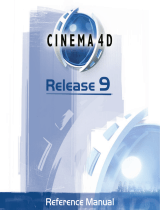
I
CINEMA 4D R16
Quickstart Manual
The software described in this document is subject to a license agreement and may only be used in accordance with the
regulations thereof.
Quickstart authors: Glenn Frey, Heiner Stiller
Layout: Kai Perschke
Copyright © 1989-2014 by MAXON Computer GmbH all rights reserved.
This manual and the accompanying software are copyright protected. No part of this document may be translated, reproduced,
stored in a retrieval system or transmitted in any form or by any means, electronic or mechanical, for any purpose, without the
express written permission of MAXON Computer. Although every precaution has been taken in the preparation of the program and
this manual, MAXON Computer assumes no responsibility for errors or omissions. Neither is any liability assumed for damages
resulting from the use of the program or from the information contained in this manual. This manual, as well as the software
described in it, is furnished under license and may be used or copied only in accordance with the terms of such license. The
content of this manual is furnished for informational use only, is subject to change without notice, and should not be construed as
a commitment by MAXON Computer. MAXON Computer assumes no responsibility or liability for any errors or inaccuracies that
may appear in this book.
The trademarks [MAXON] (DE 1 139 896, CTM 4639191, IR 950 459; registered in the European Union, the Russian Federation
and Australia), [CINEMA 4D] (DE 2 068 891, CTM 4959698, IR 664 160, JP 4 385 968, KR 40-2008-0033230; registered in
the European Union, Switzerland, the Russian Federation, USA, Japan, South Korea and China), [MAXON FORM] (CTM 4518569;
registered in the European Union) and [MoGraph] (CTM 4926771; registered in the European Union) are registered trademarks of
MAXON Computer GmbH. In addition, trademark rights can exist for MAXON Computer GmbH or MAXON Computer Inc. in various
territories for the aforementioned or other trademarks, e.g. BodyPaint 3D, RayBrush, or C.O.F.F.E.E.
Acrobat, the Acrobat logo, PostScript, Acrobat Reader, Photoshop, Flash and Director and Illustrator are trademarks of Adobe
Systems Incorporated registered in the U.S. and other countries. Apple, AppleScript, AppleTalk, ColorSync, Mac OS, QuickTime,
Macintosh and TrueType are trademarks of Apple Computer, Inc. registered in the U.S. and other countries. QuickTime and the
QuickTime logo are trademarks used under license. Microsoft, Windows, and Windows NT are either registered trademarks or
trademarks of Microsoft Corporation in the U.S. and/or other countries. UNIX is a registered trademark only licensed to X/Open
Company Ltd. All other brand and product names mentioned in this manual are trademarks or registered trademarks of their
respective companies, and are hereby acknowledged. HDRI material preview: Creative Market.
Bullet Time is a registered trademark from Warner Bros. Entertainment, Inc.
The information in this document are subject to change without notice.





































